The Tale of Two Economies: Inflationary Dynamics in the Euro Area and the US in the Context of Uncertainty
Abstract
1. Introduction
2. The Tale of Two Economies
3. Some Basic Facts about the European and American Economies
3.1. Inflation, Profits, and Wages
3.1.1. Macroeconomic Policy and Economic Growth
3.1.2. Labour Market Dynamics and the Phillips Curve
3.2. Macroeconomic Shocks, Inflation, and Uncertainty
3.2.1. Uncertainty Shocks
3.2.2. Have Shocks Ended the Great Moderation?
3.2.3. Nominal and Transitory Shocks
3.3. The Impact of Uncertainty on Inflation
3.3.1. Measures of Uncertainty
3.3.2. Uncertainty and Profit Inflation
3.3.3. Policy Effectiveness under Uncertainty
4. Conclusions
Supplementary Materials
Funding
Informed Consent Statement
Data Availability Statement
Acknowledgments
Conflicts of Interest
| 1 | The standard model for explaining inflation due to inconsistent wage and profit claims is the NAIRU (non-accelerating inflation rate of unemployment) model (Layard et al. 1991). The assumption of a stable NAIRU implies that the two claims are stable in equilibrium. However, the acceleration in inflation is only possible if wage and price claims are accommodated by monetary policy. If money is kept tight, the consequences will be an increase in unemployment. | |||||||||||||||||||||||||||
| 2 | ||||||||||||||||||||||||||||
| 3 | “From a firm’s perspective, this unchanged mark-up may be seen as an unchanged pricing strategy and may, in this respect, not be regarded as actively contributing to inflationary pressures, since profits are simply displaying the same strong dynamics as overall costs. However, from a macroeconomic and inflation analysis perspective, any increase in a component of a price contributes to inflation, regardless of whether there has been a change in the underlying pricing behaviour” (Hahn 2023). | |||||||||||||||||||||||||||
| 4 | (Bilbiie and Känzig 2023; Owens 2022; Weber and Wasner 2023). The frequency of the word “greed” has increased by 85 percent in Google’s ngram since the early 1990s. | |||||||||||||||||||||||||||
| 5 | ||||||||||||||||||||||||||||
| 6 | Data for profit shares are from the OECD database using nominal GDP by income. | |||||||||||||||||||||||||||
| 7 | Over the 2000–2019 period, US capital productivity was on average 29% above that of the EA and the profit share in Europe 30% higher. Hence, the returns on aggregate capital were roughly equal. | |||||||||||||||||||||||||||
| 8 | (Banerjee and Russell 2005) have shown that empirically, the difference between marginal cost and unit cost is not significant. Reis’ (2023) model of real marginal costs that are weighted by the capital share yield the same result. | |||||||||||||||||||||||||||
| 9 | Discrepancies are due to measurement errors and imported intermediary goods. | |||||||||||||||||||||||||||
| 10 | On 26 July 2012. For a discussion of the effects, see (ECON Committee 2022). | |||||||||||||||||||||||||||
| 11 | In the United States, low-wage workers were the first to become unemployed, which led to an increase in aggregate wage compensation per worker employed (Rouse and Gimbel 2021). | |||||||||||||||||||||||||||
| 12 | ||||||||||||||||||||||||||||
| 13 | See (Phillips 1958). The New Keynesian version of the Phillips curve relates inflation expectations to the natural rate of unemployment. Modelling inflation expectations in a climate of uncertainty is itself uncertain (see below) and estimates of the natural rate of unemployment are disputed (O. Blanchard 2018). For the purposes of comparing the US and EA, the classical articulation is sufficient. | |||||||||||||||||||||||||||
| 14 | The early literature focussed on investment with hysteresis effects on the capital stock. See (Bernanke 1998; Dixit and Pindyck 1994). For overviews of the recent literature, see (N. Bloom 2014; Istrefi and Mouabbi 2018; Pagliacci 2003; Kozeniauskasa et al. 2018). On measuring uncertainty, see (N. Bloom 2009; Jurado et al. 2015; Baker et al. 2016). | |||||||||||||||||||||||||||
| 15 | “I associate risk premium with probability strictly speaking, and liquidity premium with what in my Treatise von Probability I called ‘weight’. An essential distinction is that a risk premium is expected to be rewarded on the average by an increased return at the end of the period. A liquidity premium, on the other hand, is not even expected to be so rewarded. It is a payment, not for the expectation of increased tangible income at the end of the period, but for an increased sense of comfort and confidence during the period” (Keynes 1979, pp. 293–94). Keynes’ view of risk and uncertainty therefore resembles Knight’s (1921) famous distinction. | |||||||||||||||||||||||||||
| 16 | Hysteresis refers to an event that persists even after the factors that generated it have been removed (Cerra et al. 2020). | |||||||||||||||||||||||||||
| 17 | Balance sheet variations 2010–2023
| |||||||||||||||||||||||||||
| 18 | (Blanchard and Quah 1989) acknowledge this possibility but consider its effect negligable. | |||||||||||||||||||||||||||
| 19 | Both indices were downloaded from the FRED. | |||||||||||||||||||||||||||
| 20 | Other attempts to measure uncertainty in the Euro Area exist. (Azqueta-Gavaldón et al. 2023) created their own economic policy uncertainty (EPU) indicators for the four largest Euro Area countries by applying two unsupervised machine learning algorithms to news articles. They observed strong negative effects of uncertainty on consumption for countries such as Italy (political) and Spain (fiscal, political, and domestic regulation). Unfortunately, I could not find an updated version. (Pastorek 2023) has constructed a Euro Area integration uncertainty index (EAUI) which shows lower levels than the EPU index in recent years. Although of interest, its time series only starts in 2012 and is therefore not suitable for our analysis here. Jurado et al. (2015) have calculated monthly series for financial and real variables looking 3 and 12 months ahead. Providing econometric estimates of time-varying macroeconomic uncertainty, their estimates display significant independent variations from popular uncertainty proxies such as the WUI, suggesting that much of the variations in other proxies are not driven by uncertainty. Unfortunately, their index is based only on US data and there is no equivalent for the Euro Area. I will therefore discard these indices for the purpose of comparing the US and EA. | |||||||||||||||||||||||||||
| 21 | For reasons of space, I do not show the estimations, but the evidence can be obtained from the author on request. | |||||||||||||||||||||||||||
| 22 | Note that the cointegrating vector is in the form of the implicit function , so that the signs of the independent variables are negative when the variables have a long-run positive effect on inflation. | |||||||||||||||||||||||||||
| 23 | In the Euro Area, the wage share fell by 0.5 percent from 1999 to 2014. |
References
- Adam, Klaus. 2009. Monetary policy and aggregate volatility. Journal of Monetary Economics 56: 1–18. [Google Scholar] [CrossRef]
- Agarwal, Ruchir, and Miles Kimball. 2022. Will Inflation Remain High? Washington, DC: Finance and Development Magazine, IMF. [Google Scholar]
- Ahir, Hites, Nicholas Bloom, and Davide Furceri. 2022. World Uncertainty Index. NBER Working Paper. Cambridge, MA: National Bureau of Economic Research. [Google Scholar]
- Albrizio, Silvia, Iván Kataryniuk, Luis Molina, and Jan Schäfer. 2023. ECB Euro Liquidity Lines. IMF Working Papers 96. Washington, DC: International Monetary Fund. [Google Scholar]
- Alvarez, Jorge, and Allan Gloe Dizioli. 2023. How Costly Will Reining in Inflation Be? It Depends on How Rational We Are. IMF Working Paper WP 23/21. Washington, DC: International Monetary Fund. [Google Scholar]
- Andersson, Malin, Pedro Neves, and Carolina Nunes. 2023. Earnings calls: New evidence on corporate profits, investment and financing conditions. ECB Economic Bulletin Box 4. [Google Scholar]
- Ascari, Guido, Paolo Bonomolo, Marco Hoeberichts, and Riccardo Trezzi. 2023. The Euro Area Great Inflation Surge. DNB Analysis Series; Amsterdam: De Nederlandsche Bank. [Google Scholar]
- Azqueta-Gavaldón, Andrés, Dominik Hirschbühl, Luca Onorante, and Lorena Saiz. 2023. Sources of Economic Policy Uncertainty in the euro area. European Economic Review 152: 104373. [Google Scholar] [CrossRef]
- Baker, Scott R., Nicholas Bloom, and Steven J. Davis. 2016. Measuring Economic Policy Uncertainty. The Quarterly Journal of Economics 131: 1593–636. [Google Scholar] [CrossRef]
- Ball, Laurence, Gregory Mankiw, David Romer, George A. Akerlof, Andrew Rose, Janet Yellen, and Christopher Sims. 1988. The New Keynesian Economics and the Output-Inflation Trade-Off. Brookings Papers on Economic Activity 1988: 1–82. [Google Scholar] [CrossRef]
- Banerjee, Anindya, and Bill Russell. 2005. Inflation and measures of the markup. Journal of Macroeconomics 27: 289–306. [Google Scholar] [CrossRef][Green Version]
- Barrett, Philip, and Jonathan J. Adams. 2022. Shocks to Inflation Expectations. IMF Working Papers. Washington, DC: International Monetary Fund, vol. 22. [Google Scholar]
- Barro, Robert J., and Francesco Bianchi. 2023. Fiscal Influences on Inflation in OECD Countries, 2020–2022. In Tests of the Fiscal Theory of the Price Level. Unpublished manuscript. [Google Scholar]
- Bauer, Michael D., Ben Bernanke, and Eric Milstein. 2023. Risk Appetite and the Risk-Taking Channel of Monetary Policy. The Journal of Economic Perspectives 37: 77–100. [Google Scholar] [CrossRef]
- Benigno, Pierpaolo, and Gauti B. Eggertson. 2023. It’s Baaack; the Surge in Inflation in the 2020s and the Retrun of the Non-Linear Phillips Curve. NBER Working Paper Series wp 31197. Cambridge, MA: National Bureau of Economic Research. [Google Scholar]
- Bernanke, Ben. 1998. Irreversibility, uncertainty, and cyclical investment. Journal of Qarterly Economics 98: 85–106. [Google Scholar]
- Bernanke, Ben. 2004. The Great Moderation. In The Federal Reserve Board; February 29. Available online: https://www.federalreserve.gov/boarddocs/speeches/2004/20040220/ (accessed on 23 April 2023).
- Bhar, Ramprasad, and Girijasankar Mallik. 2010. Inflation, inflation uncertainty and output growth in the USA. Physica A 389: 5503–10. [Google Scholar] [CrossRef]
- Bilbiie, Florin O., and Diego R. Känzig. 2023. Greed? Profits, Inflation, and Aggregate Demand. NEBR Working Paper (31618). Cambridge, MA: National Bureau of Economic Research. [Google Scholar]
- Blanchard, Olivier. 2018. Should We Reject the Natural Rate Hypothesis? The Journal of Economic Perspectives 32: 97–120. [Google Scholar] [CrossRef]
- Blanchard, Olivier J., and Ben S. Bernanke. 2023. What Caused the US Pandemic-Era Inflation? NBER Working Paper (31417). Available online: http://www.nber.org/papers/w31417 (accessed on 25 October 2023).
- Blanchard, Olivier, and Thomas Philippon. 2003. The Decline of Rents and the Rise and Fall of European Unemployment. MIT, Unpublished paper. Available online: https://crei.cat/wp-content/uploads/2016/09/blanchard.pdf (accessed on 25 October 2023).
- Blanchard, Olivier, and Danny Quah. 1989. The dynamic effects of aggregate demand and supply disturbances. American Economic Review 79: 655–73. [Google Scholar]
- Blanchard, Olivier, and John Simon. 2001. The Long and Large Decline in U.S. Output Volatility. Brookings Papers on Economic Activity 2001: 135–64. [Google Scholar] [CrossRef]
- Bloom, Nicholas. 2009. The Impact of Uncertainty Shocks. Econometrica 77: 623–85. [Google Scholar]
- Bloom, Nicolas. 2014. Fluctuations in Uncertainty. Journal of Economic Perspectives 28: 153–76. [Google Scholar] [CrossRef]
- Born, Alexandra, Franziska Bremus, Wieger Kastelein, Claudia Lambert, and Natalia Martín Fuentes. 2022. A Deep Dive into Risk Sharing through the Capital Channel in the Euro Area—Inter- versus Intra-Regional Risk Sharing Financial Integration and Structure in the Euro Area. Frankfurt: ECB. [Google Scholar]
- Cerra, Valerie, Antonio Fatás, and Sweta C. Saxena. 2020. Hysteresis and Business Cycles. IMF Working Paper WP/20/73. Cambridge, MA: National Bureau of Economic Research. [Google Scholar]
- Dixit, Avinash, and Robert S. Pindyck. 1994. Investment under Uncertainty. Princeton: Princeton University Press. [Google Scholar]
- ECB. 2023. Economic, financial and monetary developments. Economic Bulletin 4: 2023. [Google Scholar]
- ECON Committee. 2022. 10 Years after “Whatever It Takes”: Fragmentation Risk in the Current Context Compilation of Papers. Luxembourg: European Parliament. [Google Scholar]
- Ehrmann, Michael, and Marcel Fratscher. 2002. Interdependence between the Euro Area and the US: What Role for EMU? ECB Working Paper No. 200. Available online: https://papers.ssrn.com/sol3/papers.cfm?abstract_id=376184 (accessed on 1 May 2024).
- Friedman, Milton. 1968. The Role of Monetary Policy. The American Economic Review 58: 1–17. [Google Scholar]
- Hahn, Elke. 2023. How have unit profits contributed to the recent strengthening of euro area domestic price pressures? ECB Economic Bulletin, Boxes 4. [Google Scholar]
- Hansen, Niels-Jakob, Frederik Toscani, and Jing Zhou. 2023. Euro Area Inflation after the Pandemic and Energy Shock: Import Prices, Profits and Wages. IMF Working Papers WP/23/131. Cambridge, MA: National Bureau of Economic Research. [Google Scholar]
- Hazell, Jonathon, Juan Herreno, Emi Nakamura, and Jon Steinsson. 2022. The Slope of the Phillips Curve: Evidence from U.S. States. Quarterly Journal of Economics 137: 1299–344. [Google Scholar] [CrossRef]
- IMF. 2013. World Economic Outlook. Washington, DC: International Monetary Fund. [Google Scholar]
- Istrefi, Klodiana, and Sarah Mouabbi. 2018. Subjective interest rate uncertainty and the macroeconomy: A cross-country analysis. Journal of International Money and Finance 88: 296–313. [Google Scholar] [CrossRef]
- Jordà, Òscar, and Sharon Projection Kozicki. 2006. Minimum Distance: An Estimator for Dynamic Macroeconomic Models. UC Davis Economics Working Paper. vol. No. 06-27, Available online: https://economics.ucr.edu/wp-content/uploads/2019/11/OscarJorda5-5-2006.pdf (accessed on 1 May 2024).
- Jurado, Kyle, Sydney C. Ludvigson, and Serena Ng Source. 2015. Measuring Uncertainty. The American Economic Review 105: 1177–216. [Google Scholar] [CrossRef]
- Keynes, John Maynard. 1979. The General Theory and After: A Supplement. The Collected Writings of John Maynard Keynes. London: Macmillan, vol. xxix. [Google Scholar]
- Knight, Frank H. 1921. Risk, Uncertainty, and Profit. Boston: Hart, Schaffner & Marx. Boston: Houghton Mifflin Company. [Google Scholar]
- Kozeniauskasa, Nicholas, Anna Orlik, and Laura Veldkamp. 2018. What are uncertainty shocks? Journal of Monetary Economics 100: 1–15. [Google Scholar] [CrossRef]
- Kuttner, Kenneth N. 2018. Outside the Box: Unconventional Monetary Policy in the Great Recession and Beyond. Journal of Economic Perspectives 32: 121–46. [Google Scholar] [CrossRef]
- Layard, Richard, Stephen Nickell, and Richard Jackman. 1991. Unemployment. Macroeconomic Performance and the Labour Market. Oxford: OUP. [Google Scholar]
- Lorenzoni, Guido, and Iván Werning. 2023. Inflation Is Conflict. In National Bureau of Economic Research Working Papers. Working Paper 31099. Cambridge, MA: National Bureau of Economic Research. Available online: http://www.nber.org/papers/w31099 (accessed on 7 February 2024).
- McNamara, Kathleen. 2015. The Forgotten Problem of Embeddedness: History Lessons for the Euro. In The Future of the Euro. Edited by R. Matthias Matthijs and Mark Blyth. Oxford: OUP, pp. 21–43. [Google Scholar]
- Neely, Christopher. 2021. Measuring Uncertainty and Volatility with FRED Data. FRED. June 25. Available online: https://fredblog.stlouisfed.org/2021/06/measuring-uncertainty-and-volatility-with-fred-data/ (accessed on 25 April 2024).
- Owens, Lindsay. 2022. Corporate Profits Are Soaring as Prices Rise: Are Corporate Greed and Profiteering Fueling Inflation? Washington DC: US Senate Committee on the Budget. Available online: https://www.budget.senate.gov/imo/media/doc/Lindsay%20Owens%20-%20Testimony%20-%20U.S.%20Senate%20Budget%20Committee.pdf (accessed on 7 April 2024).
- Pagliacci, Carolina. 2003. Comparing the inflationary impacts of uncertainty between advanced and emerging economies. Macroeconomics and Finance in Emerging Market Economies, 1–20. [Google Scholar] [CrossRef]
- Pagliari, Maria Sole. 2021. Does One (Unconventional) Size Fit All? Effects of the ECB’s Unconventional Monetary Policies on the Euro Area Economies. Working Paper 829. Paris: Banque de France. [Google Scholar]
- Pastorek, Daniel. 2023. Euro area uncertainty and Euro exchange rate volatility: Exploring the role of transnational economic policy. Finance Research Letters 58: 104351. [Google Scholar] [CrossRef]
- Pesaran, Hashem, and Yongcheol Shin. 1995. An Autoregressive Distributed Lag Modeling Approach to Co-Integration. Edited by ResearchGate. Available online: https://www.researchgate.net/publication/4800254 (accessed on 7 April 2024).
- Phillips, Alban W. 1958. The Relation between Unemployment and the Rate of Change of Money Wage Rates in the United Kingdom, 1861–1957. Economica, New Series 25: 283–99. [Google Scholar] [CrossRef]
- Reis, Ricardo. 2021. Losing the Inflation Anchor. Brookings Papers on Economic Activity 2021: 307–79. [Google Scholar] [CrossRef]
- Reis, Ricardo. 2023. Four Mistakes in the Use of Measures of Expected Inflation. AEA Papers and Proceedings 113: 47–51. [Google Scholar] [CrossRef]
- Rouse, Cecilia, and Martha Gimbel. 2021. The Pandemic’s Effect on Measured Wage Growth. In CEA—The White House; April 19. Available online: https://www.whitehouse.gov/cea/written-materials/2021/04/19/the-pandemics-effect-on-measured-wage-growth/ (accessed on 3 May 2023).
- Smets, Frank, and Raf Wouters. 2004. Comparing Shocks and Frictions in US and Euro Area Business Cycles. A Bayesian DSGE Approach. ECB Working Paper Series 391. Frankfurt am Main: European Central Bank. [Google Scholar]
- Stock, James H., and Mark W. Watson. 2001. Vector Autoregressions. The Journal of Economic Perspectives 15: 101–15. [Google Scholar] [CrossRef]
- Weber, Isabella M., and Evan Wasner. 2023. Sellers’ Inflation, Profits and Conflict: Why can Large Firms Hike Prices in an Emergency? University of Massachusetts Amherst Economics Department Working Paper Series 343; Amherst: University of Massachusetts Amherst. [Google Scholar] [CrossRef]
- Wellink, Nout. 2023. Crises have shaped the European Central Bank. Journal of International Money and Finance 138: 102923. [Google Scholar] [CrossRef]
- Whaley, Robert. 2009. Understanding the VIX. Journal of Portfolio Management 35: 98–105. [Google Scholar] [CrossRef]
- Yellen, Janet L. 2012. Revolution and Evolution in Central Bank Communications. In Board of Governors of the Federal Reserve System; November 13. Available online: https://www.federalreserve.gov/newsevents/speech/yellen20121113a.htm (accessed on 24 April 2023).
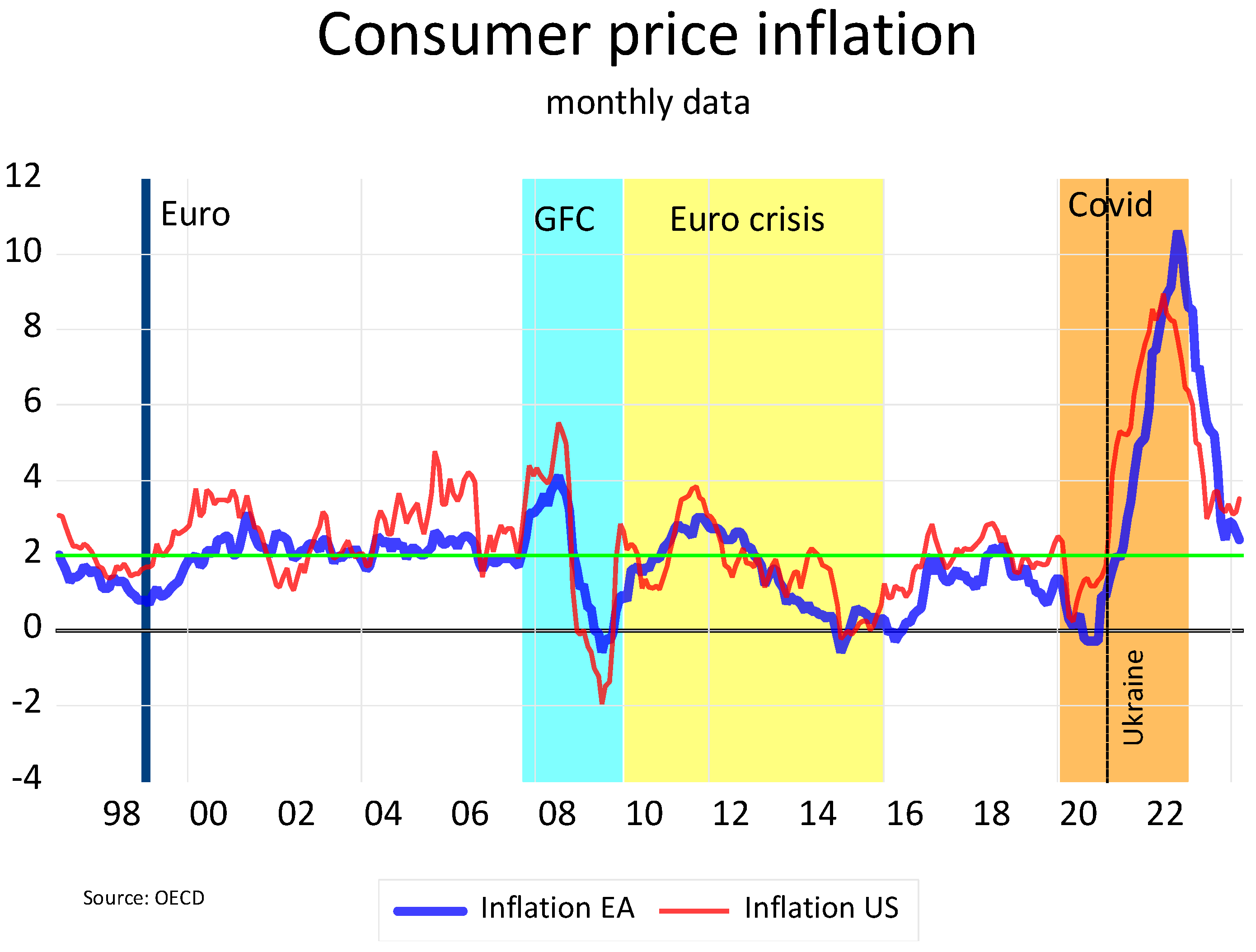
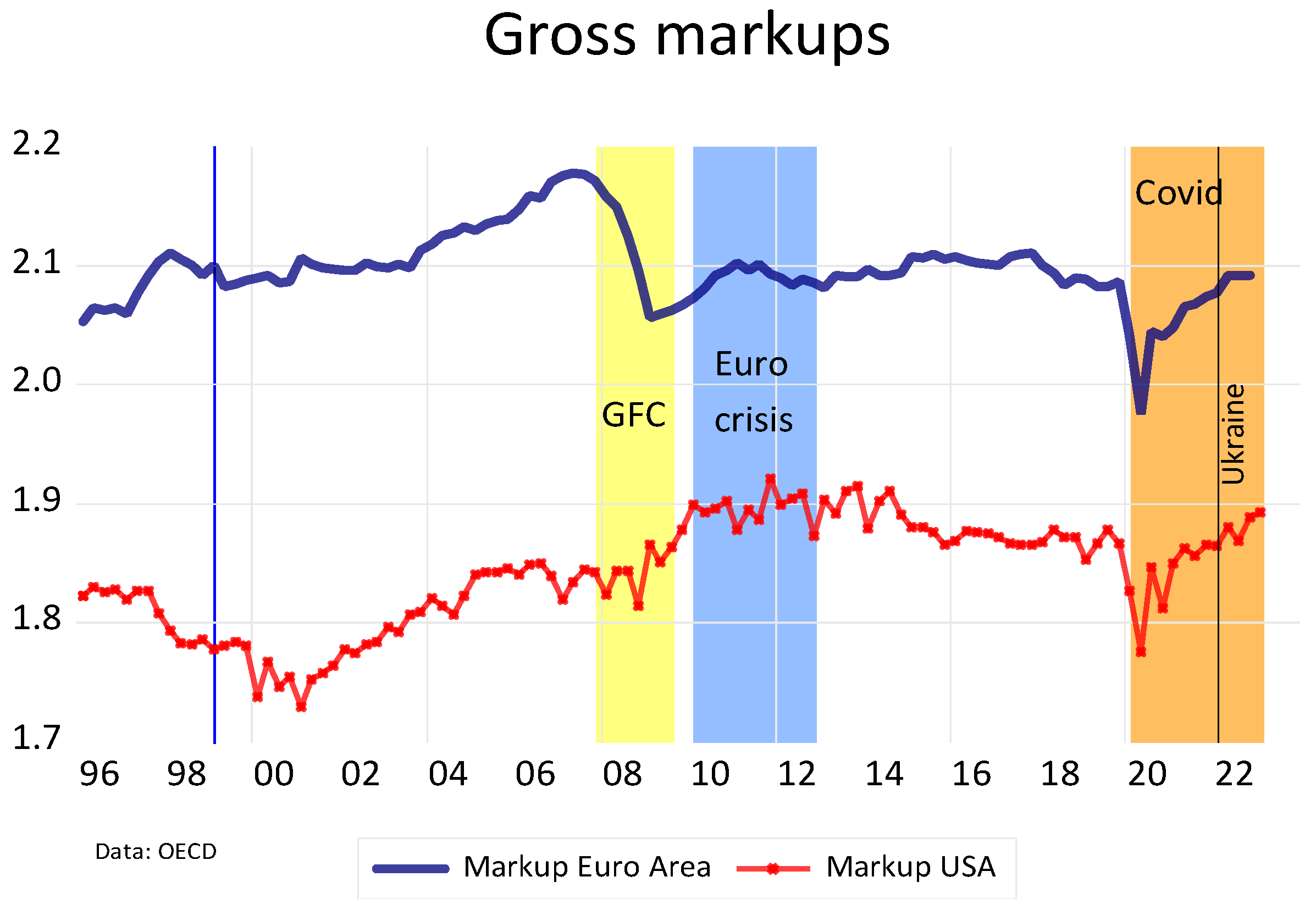
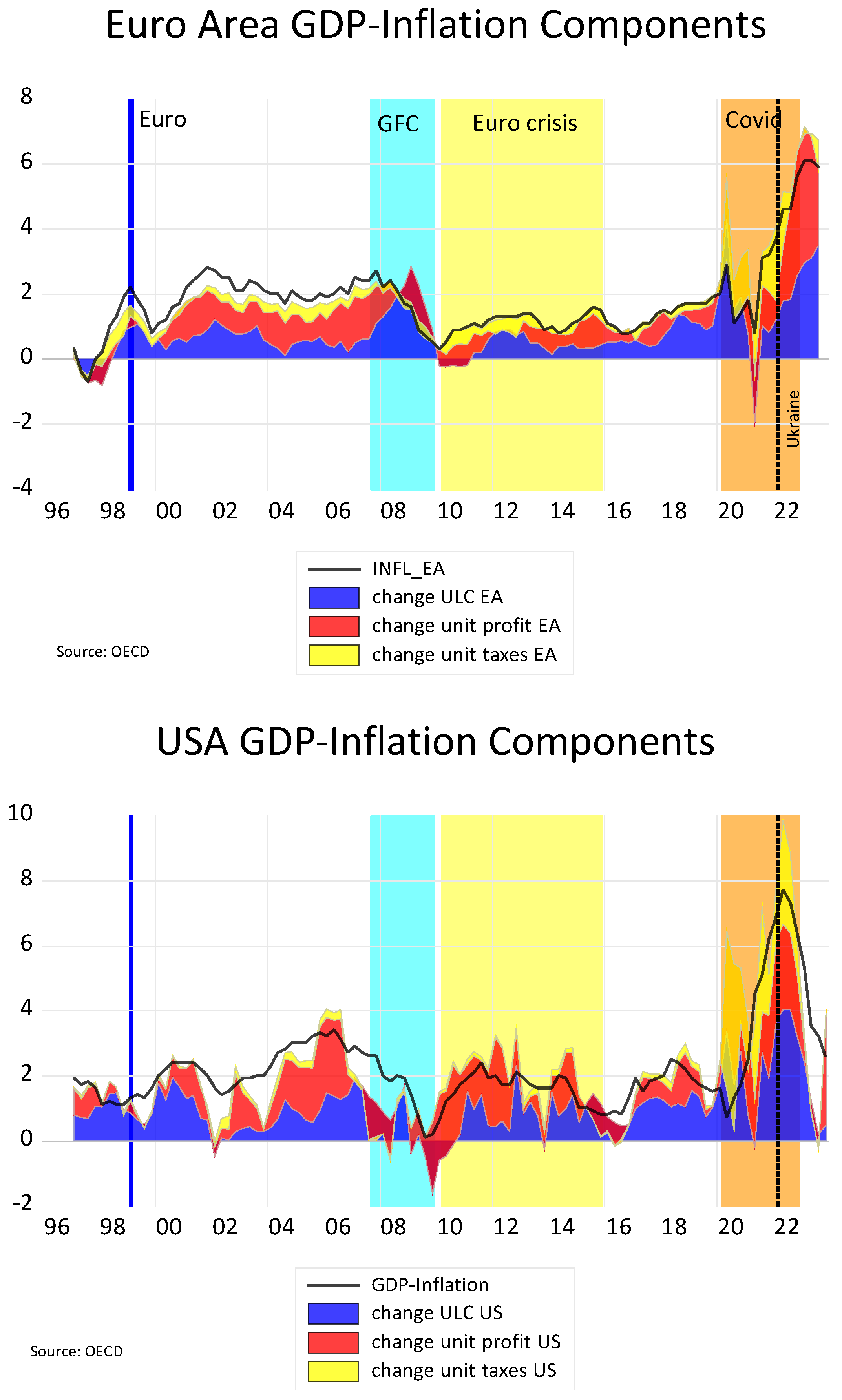
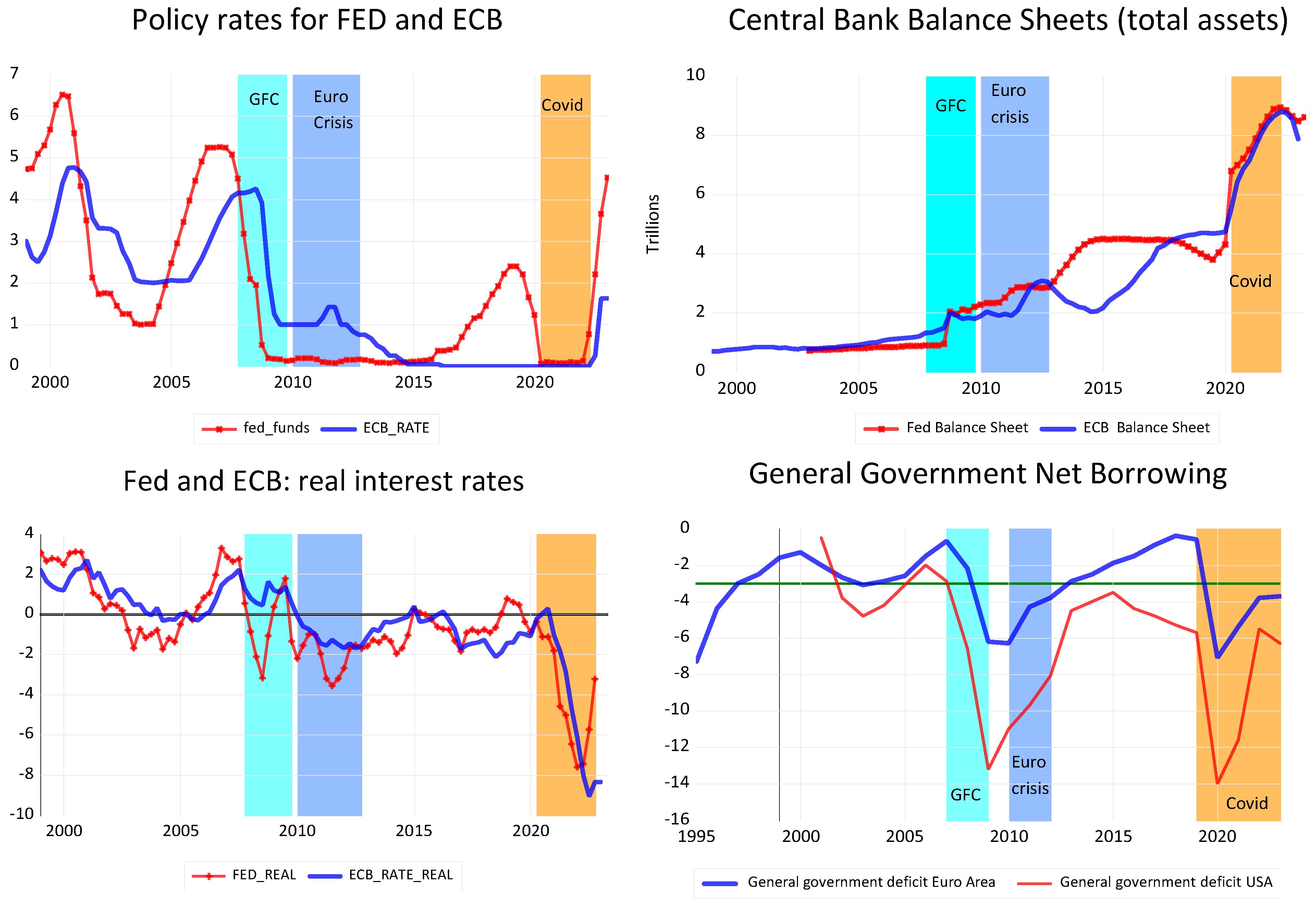
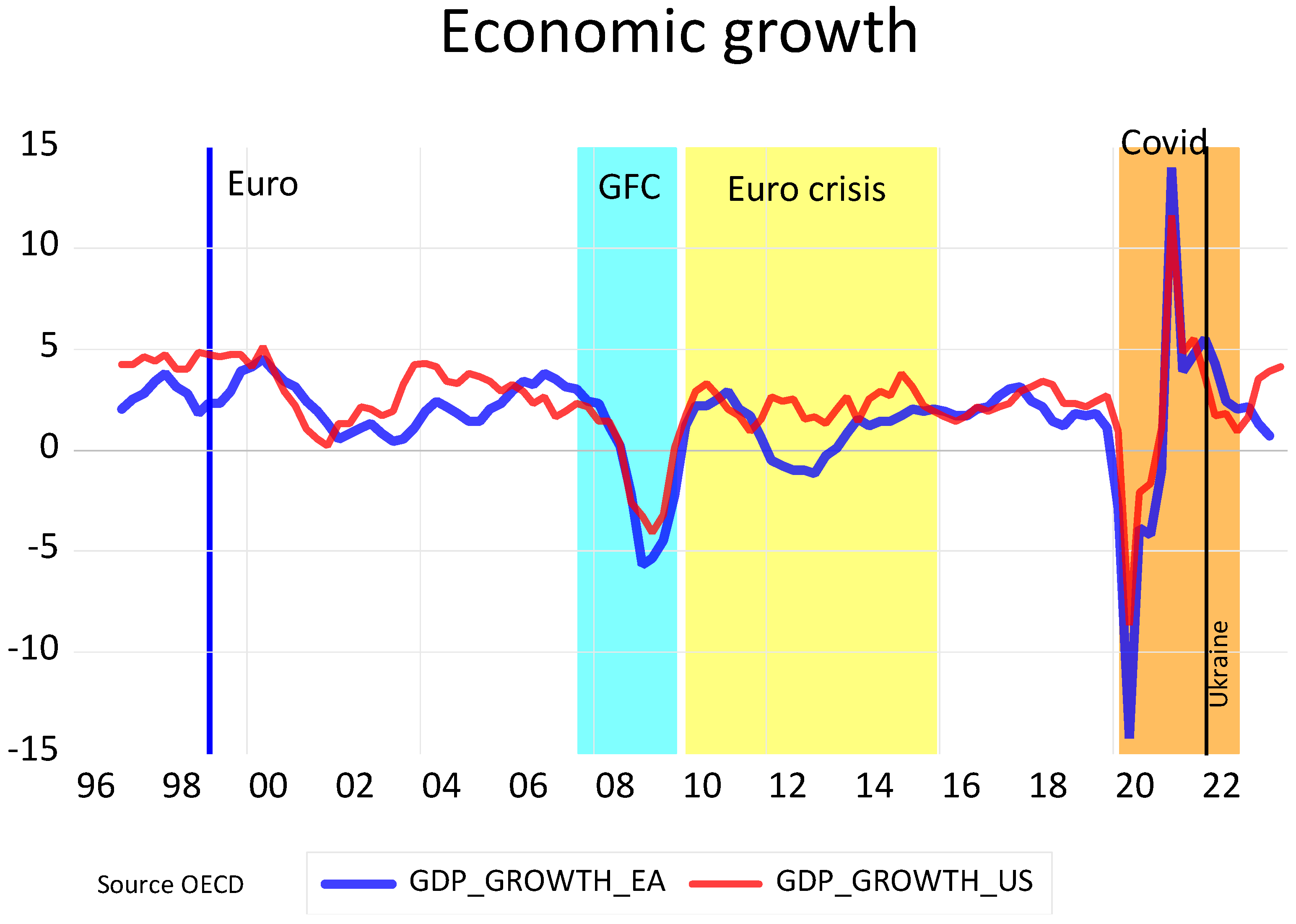
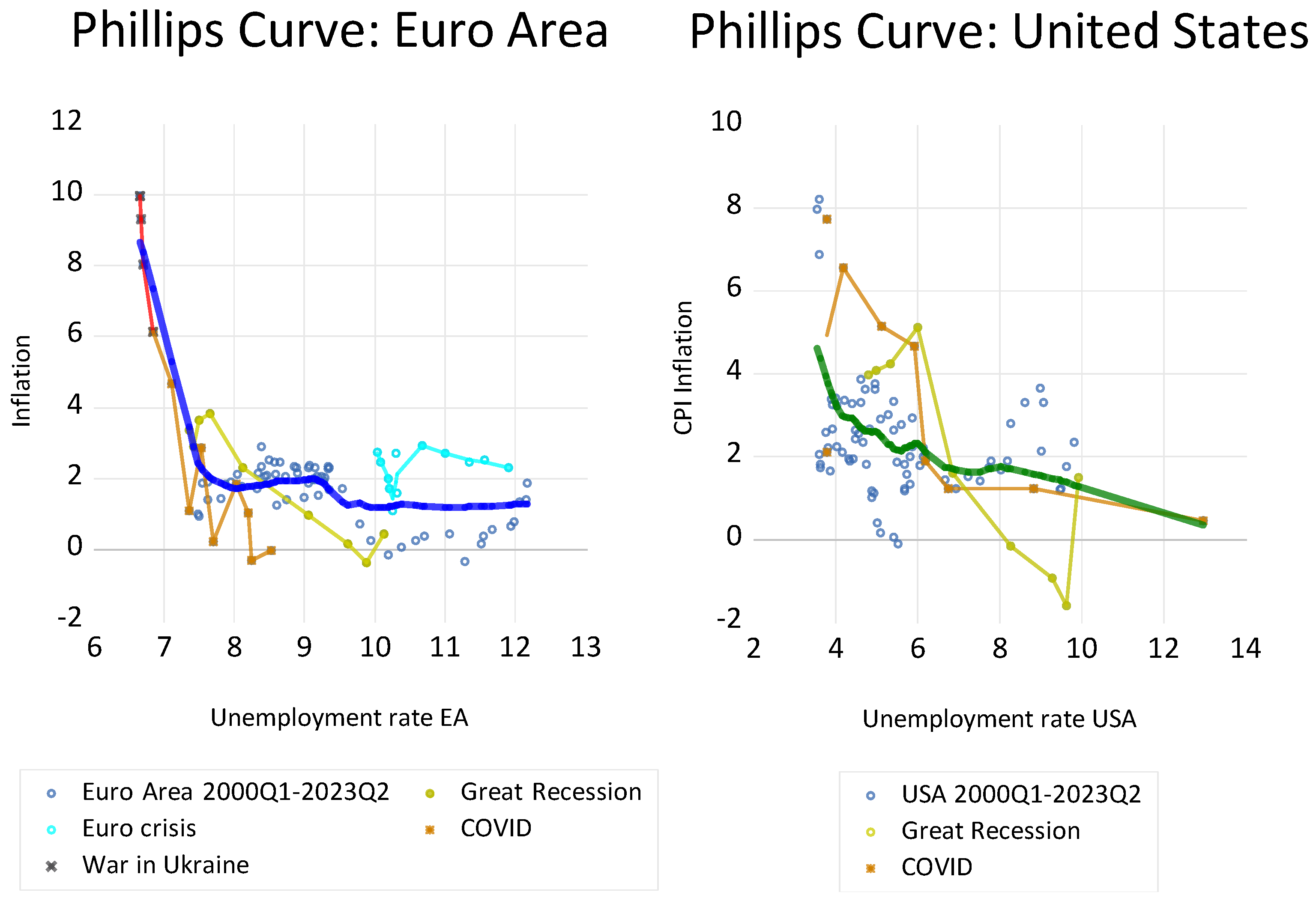
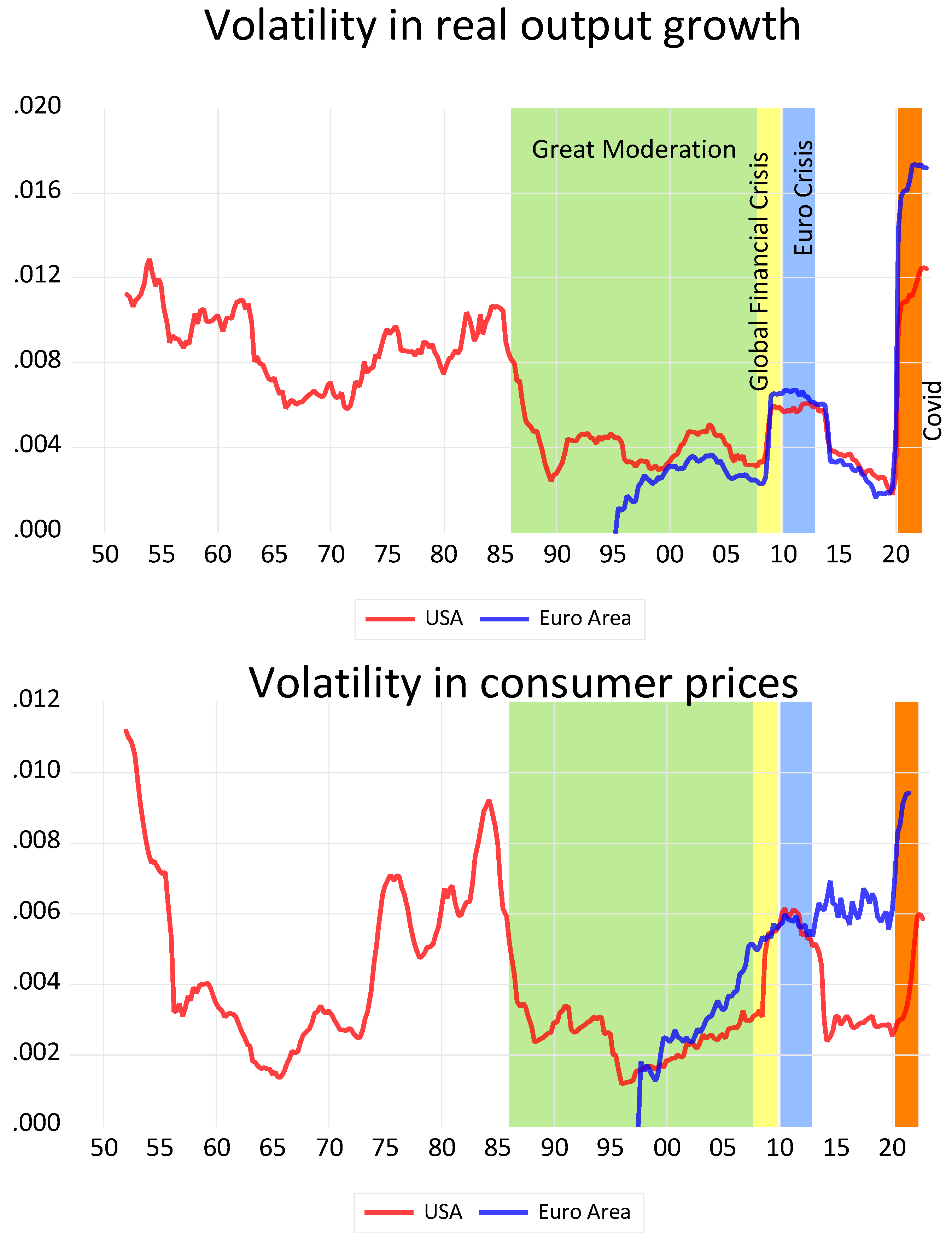
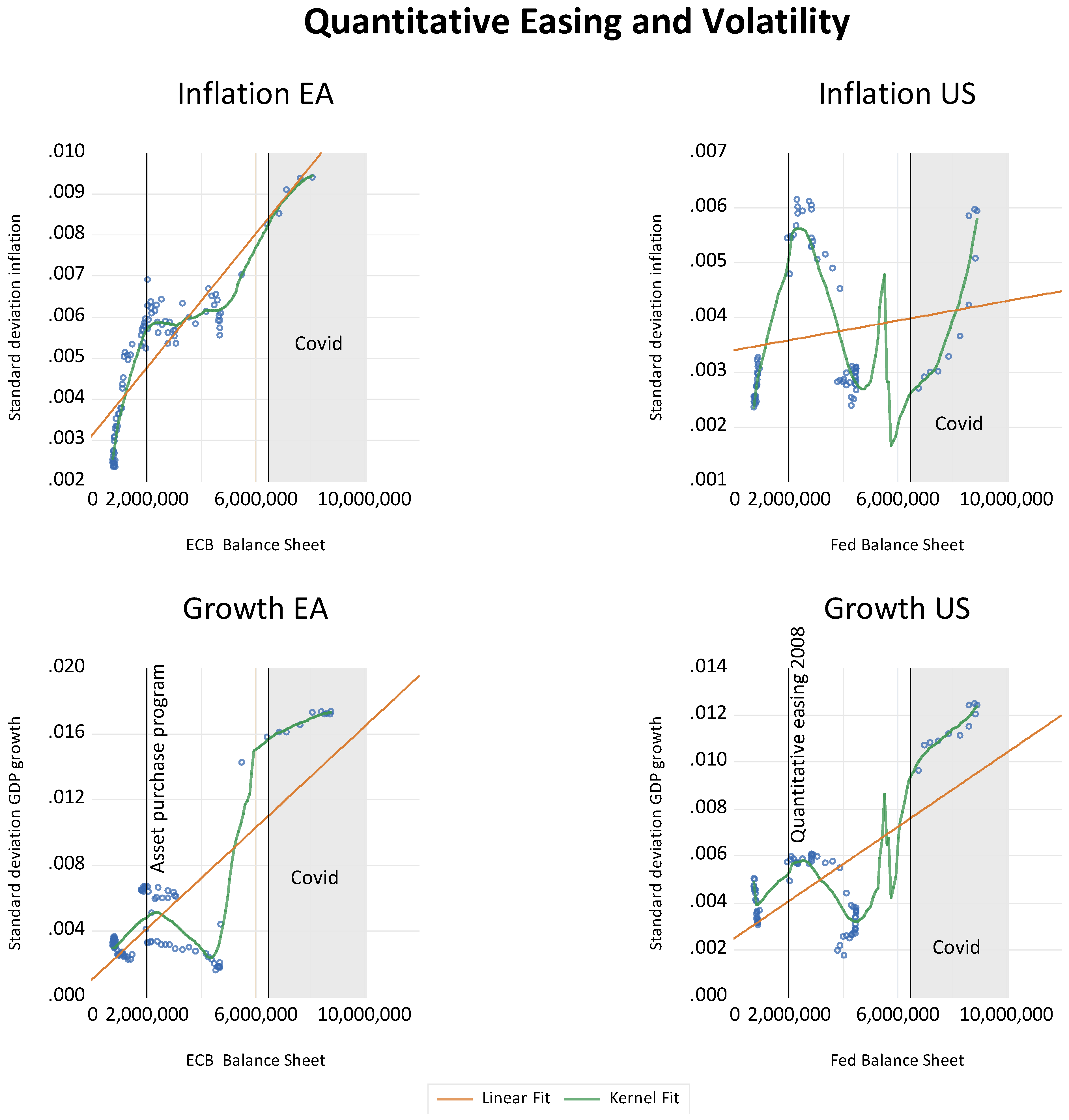
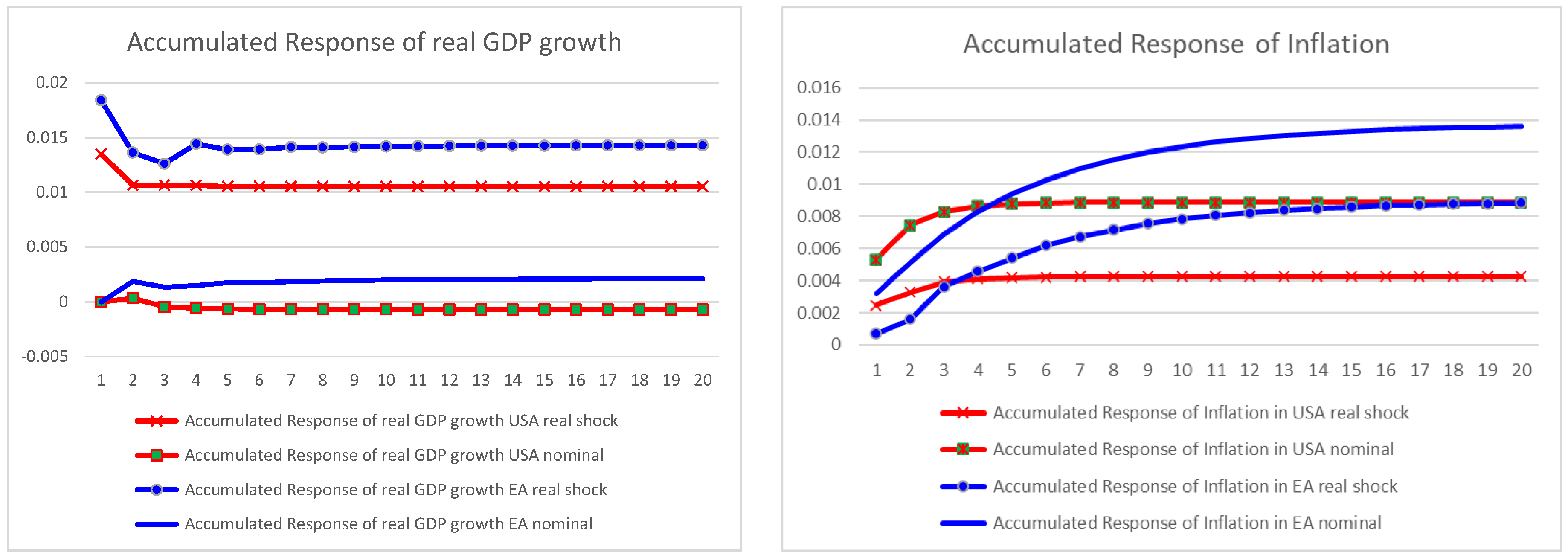
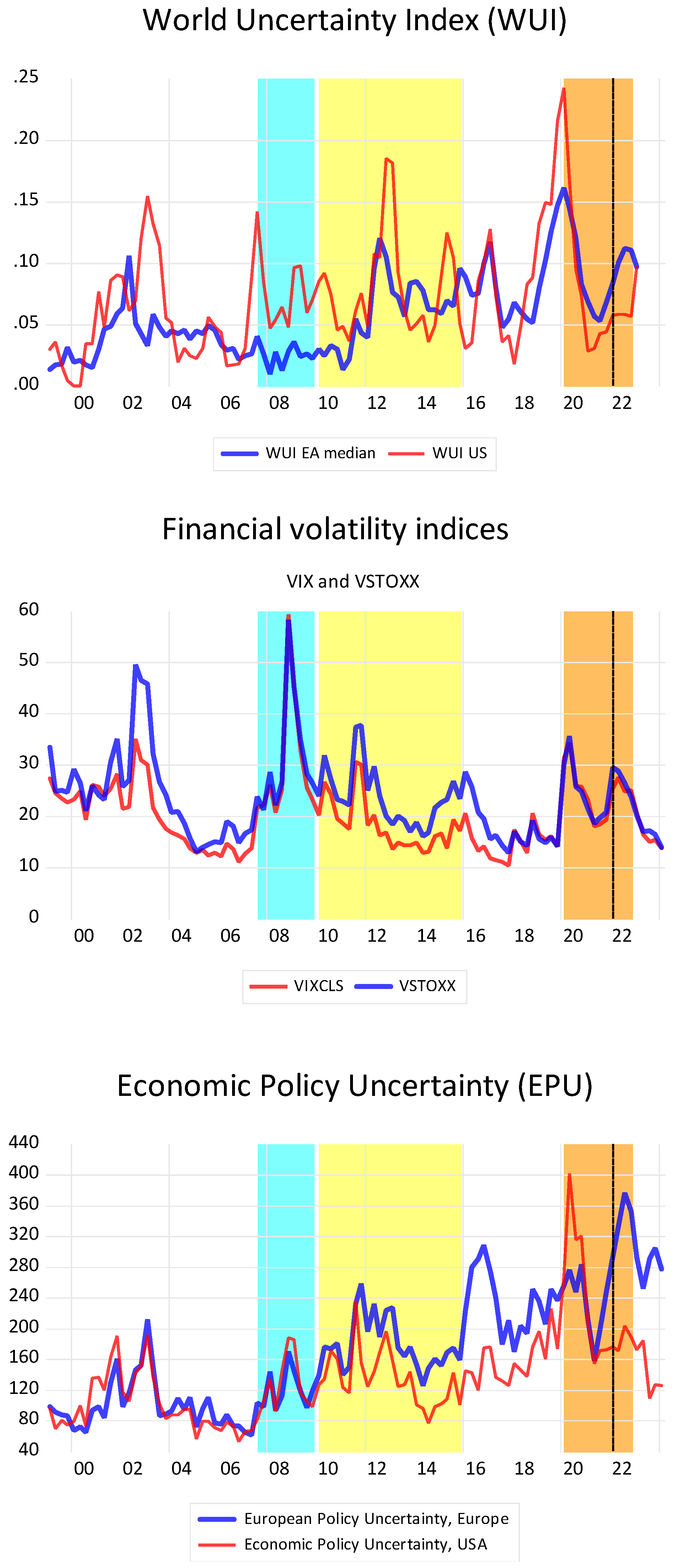
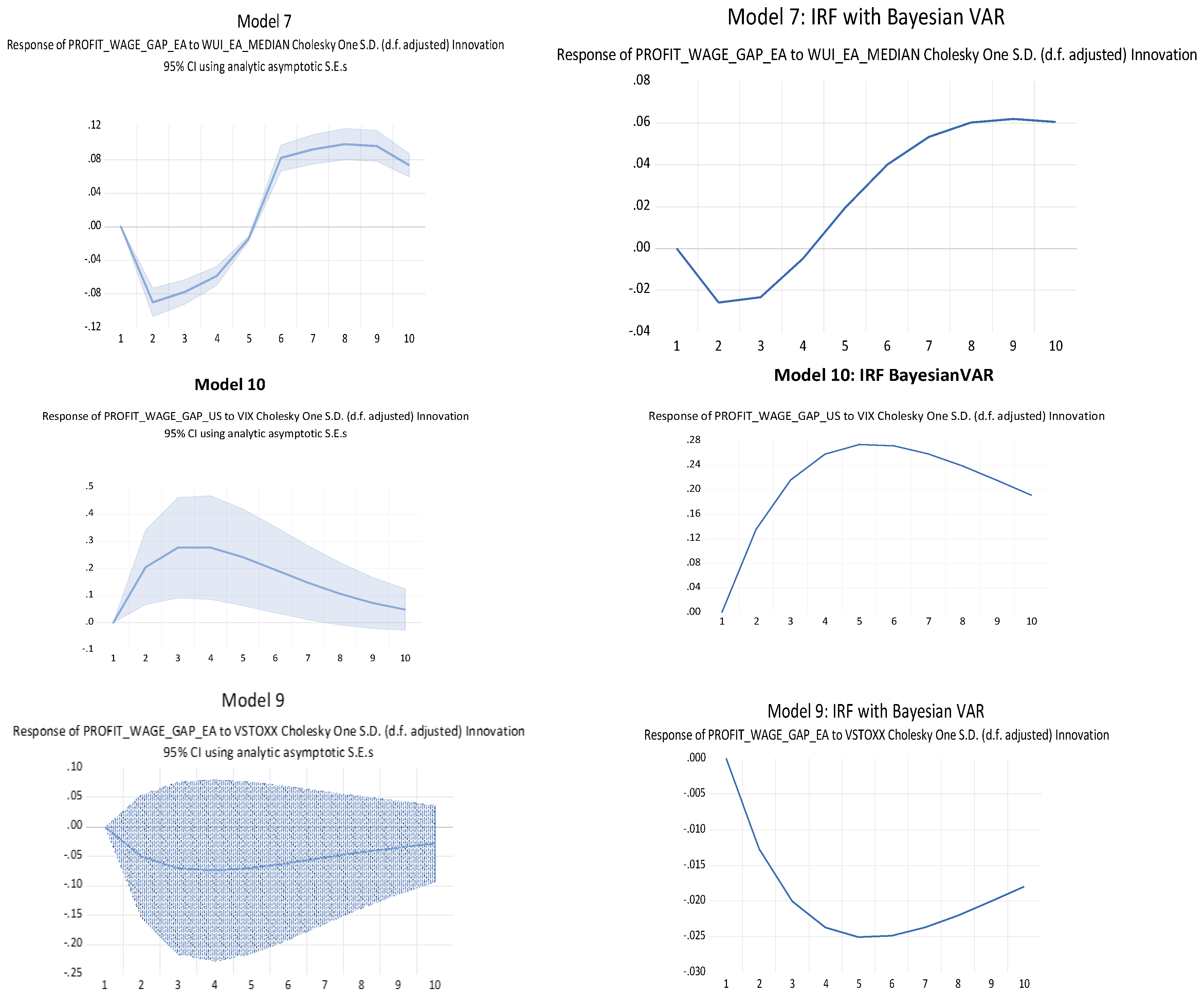


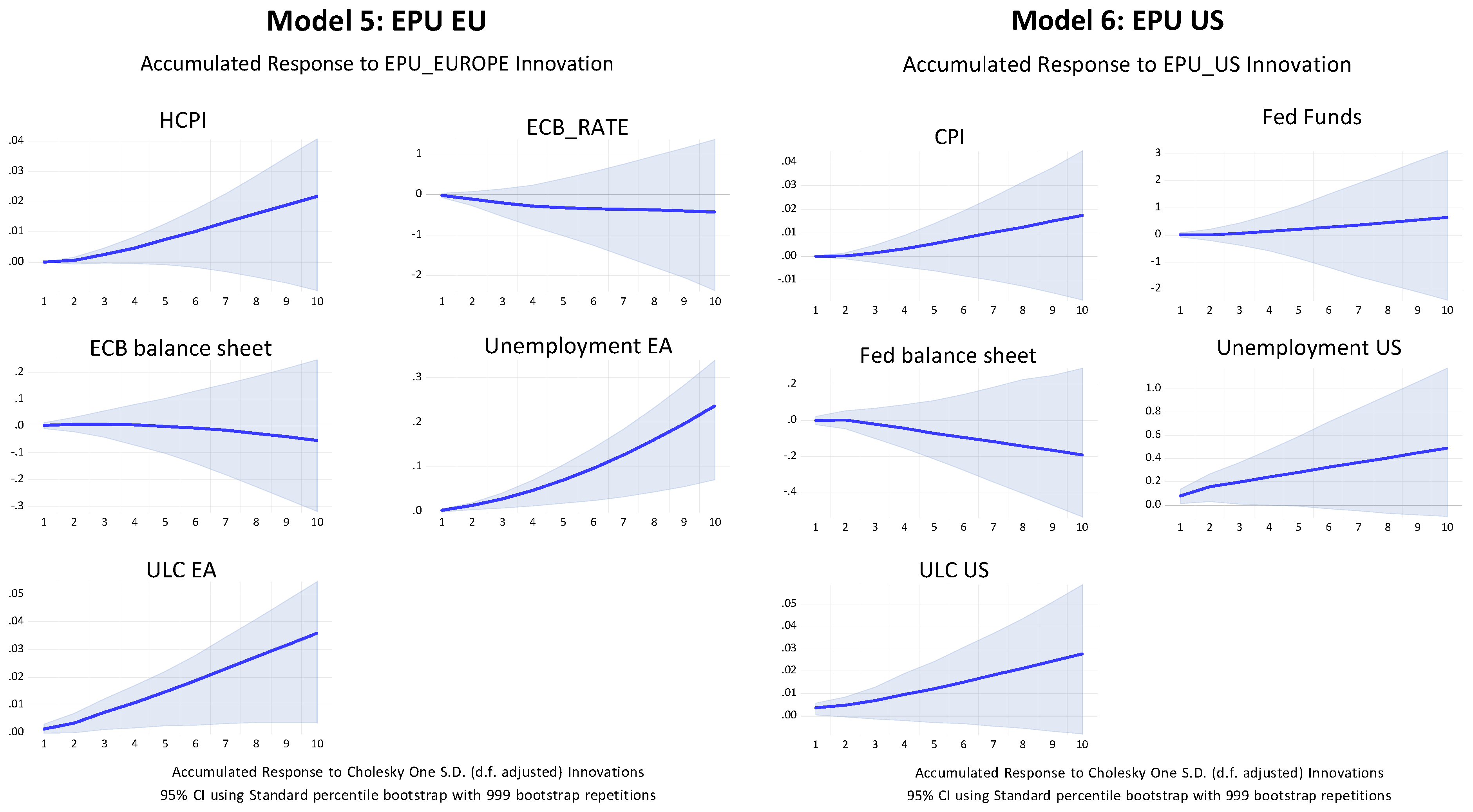
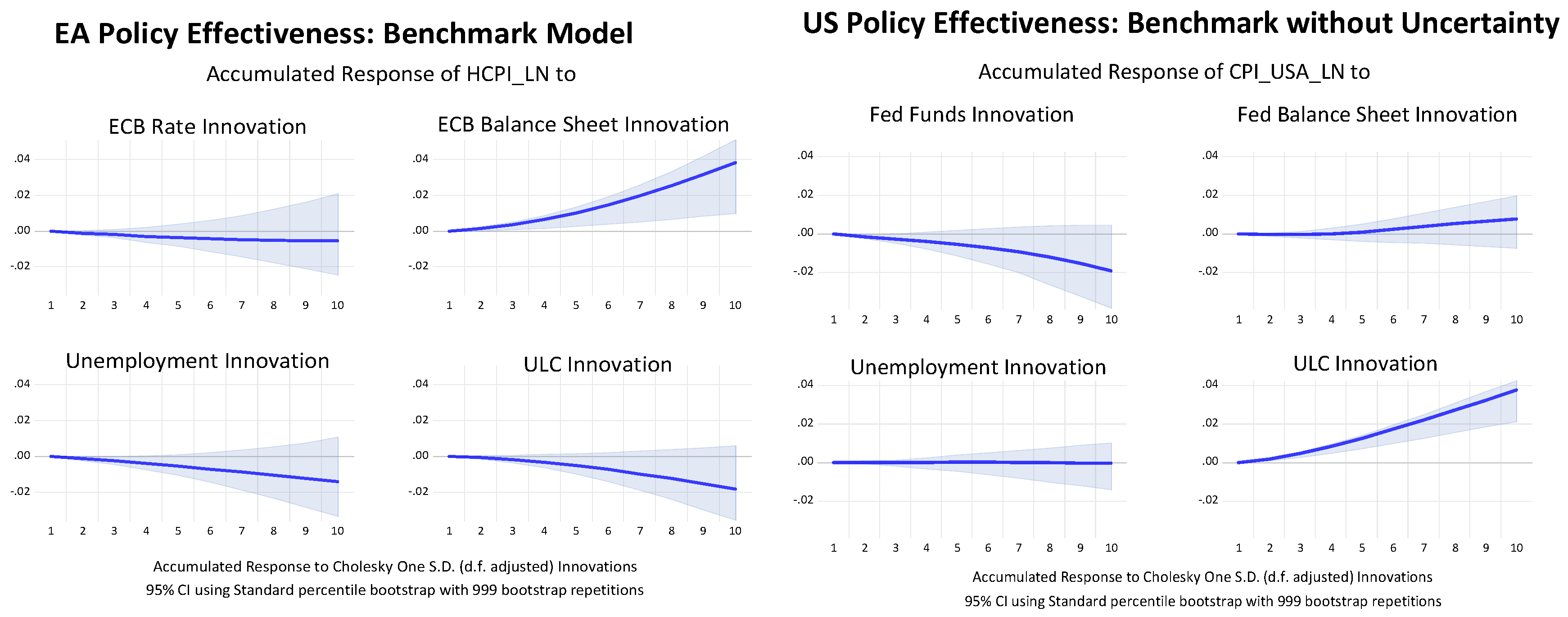
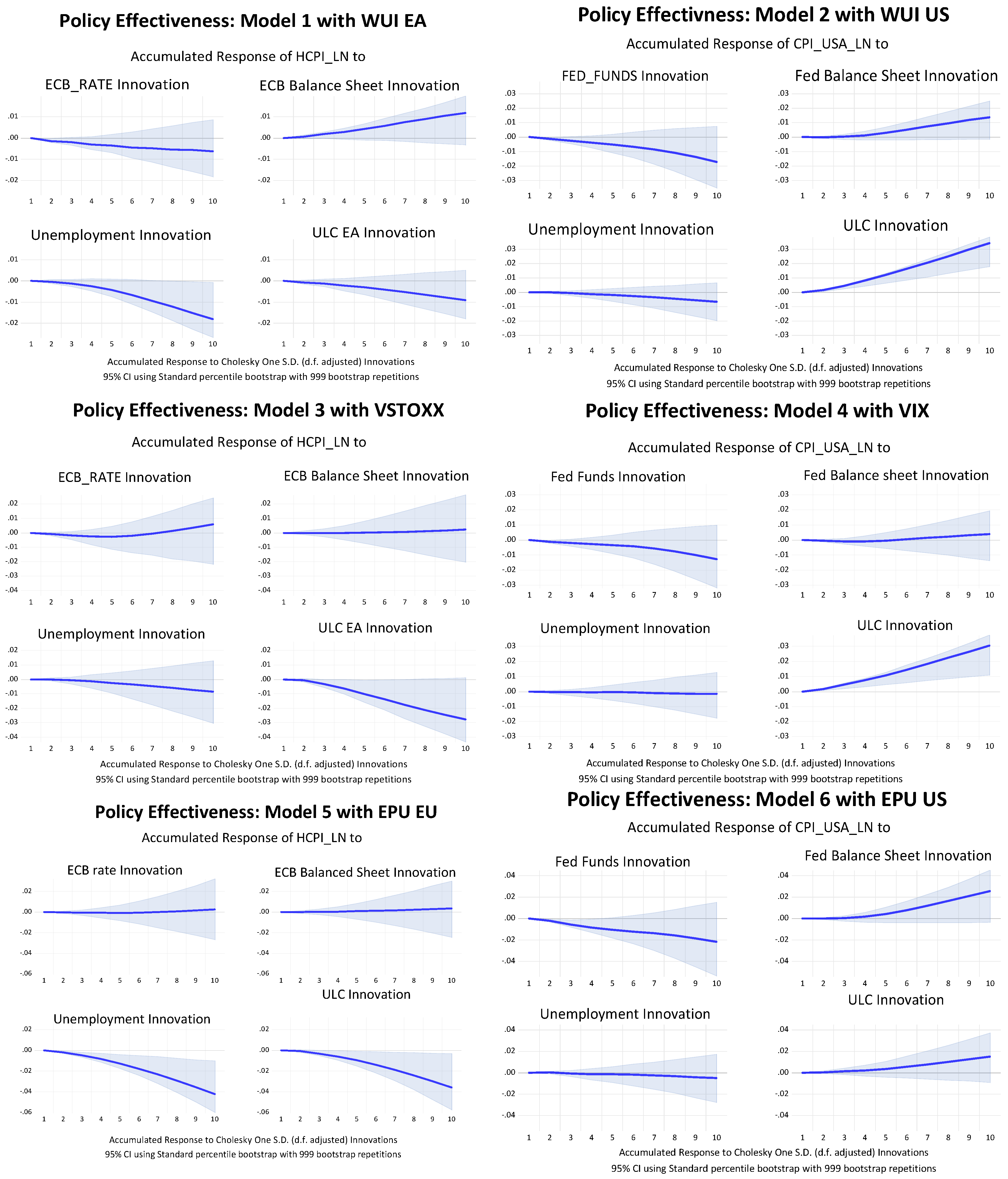
| Average Rates 1999Q1–2023Q1 | ||||||||||
|---|---|---|---|---|---|---|---|---|---|---|
| Inflation | GDP Growth | Unemployment | Central Bank Interest | Budget Deficit (Annual) | ||||||
| EA | USA | EA | USA | EA | USA | ECB | FED | EA | USA | |
| Mean | 1.95 | 2.44 | 1.40 | 2.16 | 9.21 | 5.79 | 1.56 | 1.81 | −3.0 | −6.1 |
| Median | 1.88 | 2.10 | 1.83 | 2.19 | 9.10 | 5.22 | 1.00 | 1.15 | −2.7 | −4.8 |
| Maximum | 9.97 | 8.21 | 14.25 | 12.46 | 12.17 | 12.97 | 4.77 | 6.52 | −0.4 | −0.5 |
| Minimum | −0.37 | −1.62 | −14.24 | −8.35 | 6.67 | 3.57 | 0.00 | 0.06 | −7.1 | −14.0 |
| Std. Dev. | 1.68 | 1.67 | 2.94 | 2.30 | 1.41 | 1.94 | 1.53 | 1.96 | 1.87 | 3.58 |
| 1999Q1–2023Q4 | 1999Q2–2006Q4 | 2006Q4–2015Q4 | 2015Q4–2019Q4 | 2019Q4–2023Q4 | |
|---|---|---|---|---|---|
| Euro Area | |||||
| Mean | 1.964 | 2.092 | 1.615 | 1.125 | 3.526 |
| Median | 1.900 | 2.133 | 1.767 | 1.400 | 1.833 |
| Maximum | 9.967 | 2.900 | 3.833 | 2.133 | 9.967 |
| Minimum | −0.367 | 0.967 | −0.367 | −0.133 | −0.300 |
| Std. Dev. | 1.681 | 0.390 | 1.129 | 0.675 | 3.687 |
| Skewness | 2.530 | −1.088 | 0.034 | −0.503 | 0.662 |
| Kurtosis | 12.058 | 4.864 | 2.041 | 2.114 | 1.908 |
| Observations | 95 | 31 | 37 | 17 | 13 |
| United States | |||||
| Mean | 2.445 | 2.685 | 1.804 | 1.806 | 4.307 |
| Median | 2.104 | 2.748 | 1.760 | 1.873 | 4.666 |
| Maximum | 8.210 | 3.849 | 5.119 | 2.651 | 8.210 |
| Minimum | −1.620 | 1.224 | −1.620 | 0.400 | 0.428 |
| Std. Dev. | 1.675 | 0.749 | 1.433 | 0.609 | 2.924 |
| Skewness | 1.194 | −0.281 | −0.028 | −0.659 | 0.079 |
| Kurtosis | 5.829 | 1.949 | 3.188 | 2.898 | 1.367 |
| Observations | 95 | 31 | 37 | 17 | 13 |
| 1999Q1–2023Q3 | 1999Q1–2006Q4 | 2006Q4–2015Q4 | 2015Q4–2019Q4 | 2019Q4–2023Q4 | |
|---|---|---|---|---|---|
| Euro Area | |||||
| Mean | −0.127 | 0.185 | −0.265 | −0.327 | 0.109 |
| Median | −0.342 | 0.243 | 0.040 | −0.217 | 0.064 |
| Maximum | 3.826 | 1.119 | 1.119 | 0.394 | 3.368 |
| Minimum | −2.696 | −1.036 | −3.970 | −1.400 | −2.970 |
| Std. Dev. | 1.271 | 0.517 | 1.221 | 0.501 | 1.516 |
| Skewness | 0.490 | −0.407 | −1.438 | −0.547 | 0.065 |
| Kurtosis | 2.994 | 2.618 | 4.587 | 2.588 | 3.161 |
| United States | |||||
| Mean | −0.105 | −0.126 | −0.035 | −0.693 | −0.485 |
| Median | −0.009 | 0.123 | −0.106 | −0.666 | −1.073 |
| Maximum | 3.368 | 1.653 | 3.826 | 0.635 | 2.188 |
| Minimum | −3.970 | −2.696 | −2.696 | −2.179 | −1.844 |
| Std. Dev. | 1.025 | 1.085 | 1.670 | 0.591 | 1.332 |
| Skewness | −0.895 | −0.564 | 0.319 | −0.257 | 1.056 |
| Kurtosis | 6.358 | 2.678 | 2.208 | 4.650 | 2.731 |
| WUI US | WUI EA | US/EA | VIX | VSTOXX | US/EA | EPU US | EPU EU | US/EA | |
|---|---|---|---|---|---|---|---|---|---|
| Mean | 0.070582 | 0.057413 | 1.22938 | 20.17193 | 23.59775 | 0.85482 | 137.0022 | 170.544 | 0.80332 |
| Median | 0.057821 | 0.050252 | 1.15062 | 18.61484 | 22.67708 | 0.82087 | 131.8727 | 159.4932 | 0.82682 |
| Maximum | 0.242228 | 0.160458 | 1.5096 | 59.37754 | 58.3387 | 1.01781 | 401.7161 | 376.2083 | 1.0678 |
| Minimum | 0 | 0.009556 | 0 | 10.30887 | 12.86535 | 0.80129 | 52.08923 | 60.33488 | 0.86334 |
| Std. Dev. | 0.046333 | 0.033688 | 1.37536 | 7.547838 | 8.355102 | 0.90338 | 57.19779 | 76.45095 | 0.74816 |
| Skewness | 1.239834 | 0.862246 | 1.43791 | 1.889143 | 1.530136 | 1.23462 | 1.624418 | 0.504537 | 3.21962 |
| Kurtosis | 4.771746 | 3.224776 | 1.47971 | 9.423378 | 6.113328 | 1.54145 | 7.555263 | 2.362903 | 3.19745 |
| Correlation | 0.57255 | 0.90553 | 0.67829 | ||||||
| Observations | 97 | 97 | 101 | 101 | 101 | 101 |
| Gap EA | Gap US | WUI EA | WUI US | VSTOXX | VIX | EPU EA | EPU US | |
|---|---|---|---|---|---|---|---|---|
| unit root test | I(0) | I(0) | I(1) | I(0) | I(0) | I(0) | I(1) | I(0) |
| trend | no | no | yes | no | no | no | yes | no |
| Granger causality | yes | yes | ||||||
| Model | 1 | 2 | 3 | 4 | 5 | 6 | ||
| ARDL (p,q) | (4,2) | (4,1) | (4,0) | −4.4 | (4,0) | (4,1) | ||
| Bound test F-statistic | 8.477641 | 4.652784 | 11.46773 | 9.1158 | 9.689139 | 8.036239 | ||
| Bounds critical value I(1) | 5.917 *** | 4.303 ** | 5.917 *** | 5.917 *** | 5.917 *** | 5.917 *** | ||
| CI coefficient | 2.622362 | 2.172509 | −0.33965 ** | 0.00685 * | −0.00069 | 0.003424 | ||
| CI p-value | 0.608028 | 0.637667 | 0.0418 | 0.0699 | 0.718124 | 0.413512 | ||
| Model | 7 | 8 | 9 | 10 | 11 | 12 | ||
| VAR (ordinary) | ||||||||
| lags | 7 | 2 | 1 | 1 | 7 | 1 | ||
| serial autocorrelation | yes | no | no | no | no | no | ||
| IRF direction | −Q4+ | + | −Q4+ | + | - | + | ||
| 95% significance | serial projection | local projection | no | no | no | ? | ||
| VAR Baysian IR direction | −Q4+ | + | - | + | +Q5− | + | ||
| Benchmark EA | Benchmark USA | Model 1 | Model 2 | Model 3 | Model 4 | Model 5 | Model 6 | |
|---|---|---|---|---|---|---|---|---|
| WUI EA | WUI US | VSTOXX | VIX | EPU EU | EPU US | |||
| Sample (adjusted): | 1999Q1–2019Q$ | 2003Q4–2023Q1 | 1999Q4–2022Q4 | 2003Q4–2023Q1 | 1999Q4–2022Q4 | 2003Q4–2023Q1 | ||
| Standard errors in ( ) & t-statistics in [ ] | ||||||||
| CPI | 1 | 1 | 1 | 1 | 1 | 1 | ||
| Uncertainty | −0.35614814 | −0.041380411 | −0.00293918 | −0.00054953 | −0.0017 | −0.002 | ||
| (-) | 0.050919527 | 0.017879572 | 0.000732979 | 0.000124894 | 0.000322 | 0.000315 | ||
| [−6.99433] | [−2.31440] | [−4.00991] | [−4.39994] | [−5.39700] | [−6.36506] | |||
| CBK interest rate | 0.034616407 | 0.001054914 | 0.011585977 | −0.000120899 | 0.005264345 | 0.000111976 | 0.024182 | −0.03997 |
| (+) | 0.0179113 | 0.001017457 | 0.003237319 | 0.000958844 | 0.006553723 | 0.001019969 | 0.017524 | 0.012362 |
| [1.93266] | [1.03681] | [3.57888] | [−0.12609] | [0.80326] | [0.10978] | [1.37995] | [−3.23292] | |
| CBK balance sheet | −0.37855436 | −0.02407724 | −0.05498855 | −0.03507625 | −0.05742392 | −0.0340643 | −0.01756 | −0.5121 |
| (-) | 0.074834714 | 0.004946053 | 0.015690081 | 0.005956499 | 0.024448902 | 0.005423651 | 0.070735 | 0.100148 |
| [−5.05854] | [−4.86797] | [−3.50467] | [−5.88874] | [−2.34873] | [−6.28070] | [−0.24825] | [−5.11305] | |
| Unemployment | 0.036557722 | 0.005797792 | 0.129379018 | 0.007548425 | −0.042235685 | 0.011103641 | 0.66444 | 0.22255 |
| (+) | 0.106257532 | 0.003686757 | 0.030818669 | 0.003586356 | 0.049298797 | 0.004072833 | 0.141459 | 0.057237 |
| [0.34405] | [1.57260] | [4.19807] | [2.10476] | [−0.85673] | [2.72627] | [4.69708] | [3.88827] | |
| ULC | 2.508504369 | −0.87772677 | 0.099605117 | −0.85026006 | 1.037038106 | −0.8040728 | −4.2378 | −0.96193 |
| (-) | 0.548430777 | 0.031818648 | 0.199197121 | 0.041523397 | 0.455296238 | 0.036110679 | 1.223552 | 0.525008 |
| [4.57397] | [−27.5853] | [0.50003] | [−20.4766] | [2.27772] | [−22.2669] | [−3.46355] | [−1.83223] | |
| trend | −7.83436445 | −0.00285497 | 0.000247389 | −0.00661665 | 0.02208 | 0.01994 | ||
| 1.183931957 | 0.000881835 | 0.000245067 | 0.001989826 | 0.005327 | 0.003698 | |||
| [−6.61724] | [−3.23753] | [1.00947] | [−3.32524] | [4.14497] | [5.39269] | |||
| c | −0.23049628 | −0.866075232 | −0.03886833 | −0.899868379 | −5.484482826 | −1.070459887 | −0.1679 | 1.419099 |
| 0.032818431 | 0.005244276 | 0.030186 | ||||||
| [−7.02338] | [−7.41157] | [−5.56238] | ||||||
| oil price exogenous | −0.07143404 | |||||||
| oil price | −3.523668193 | 5.566866 | ||||||
Disclaimer/Publisher’s Note: The statements, opinions and data contained in all publications are solely those of the individual author(s) and contributor(s) and not of MDPI and/or the editor(s). MDPI and/or the editor(s) disclaim responsibility for any injury to people or property resulting from any ideas, methods, instructions or products referred to in the content. |
© 2024 by the author. Licensee MDPI, Basel, Switzerland. This article is an open access article distributed under the terms and conditions of the Creative Commons Attribution (CC BY) license (https://creativecommons.org/licenses/by/4.0/).
Share and Cite
Collignon, S. The Tale of Two Economies: Inflationary Dynamics in the Euro Area and the US in the Context of Uncertainty. Economies 2024, 12, 157. https://doi.org/10.3390/economies12070157
Collignon S. The Tale of Two Economies: Inflationary Dynamics in the Euro Area and the US in the Context of Uncertainty. Economies. 2024; 12(7):157. https://doi.org/10.3390/economies12070157
Chicago/Turabian StyleCollignon, Stefan. 2024. "The Tale of Two Economies: Inflationary Dynamics in the Euro Area and the US in the Context of Uncertainty" Economies 12, no. 7: 157. https://doi.org/10.3390/economies12070157
APA StyleCollignon, S. (2024). The Tale of Two Economies: Inflationary Dynamics in the Euro Area and the US in the Context of Uncertainty. Economies, 12(7), 157. https://doi.org/10.3390/economies12070157






